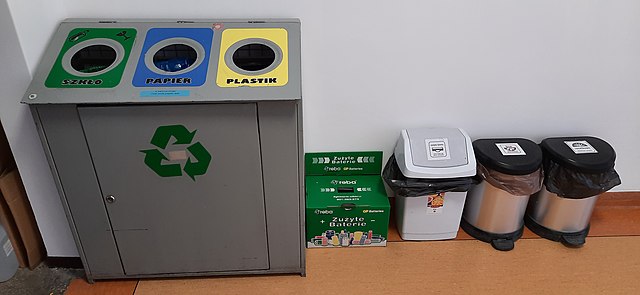Recycling is when you recover scrap or waste and reprocessing the material into useful products. Glass, paper, plastic, and metals such as aluminum and steel are often recycled. Dead plants dead and vegetable scraps can be recycled through composting.


It is important not to confuse recycling with reusing, which is where old things, such as clothes, are donated or given a new use instead of being thrown out.[1]
Recycling reduces trash in landfills and incinerators. Another reason people recycle is to reduce the amount of raw materials and energy used in making things. Most of the time, it takes less energy to recycle trash than to throw it away, The Economist says. Recycling can reduce your carbon footprint and it can help to minimize the whole size of landfills around the world
The 3 R's are Reduce, Reuse, and Recycle.
Plastic recycling
Most people make about two kilograms of waste (trash) every day, and about 7% of this waste is made up of plastic products that can be recycled. Today, plastic can be recycled into products like picnic tables, park benches, and even high-chairs.[2]
Sort it out
First, plastic is collected and taken to a recycling center, where it is sorted out. When plastic is sorted out by hand, symbols have to be printed on every recyclable plastic product used. Nowadays, machines can sort out the plastic automatically. There are different types of plastic, for example polyethylene, polypropylene, polystyrene, and polyethylene terephthalate. There are two kinds of polyethylene plastic: high density polyethylene (HDPE), and low density polyethylene (LDPE). HDPE plastic is usually used to make milk bottles and bottles for shampoo or detergents. LDPE plastic are usually things like toothpaste tubes, plastic bags, and films for packaging. Polypropylene plastic is used to make buckets, plastic boxes, and flower pots. Polyethylene terephthalate is the material from which water and soft drink bottles are made.
Grinding washing
HDPE plastic is ground into a small powder.[2] LDPE plastic, which are usually thin films, need to be ground by a special machine.[2] After that, both plastics are washed with hot water and detergent.[2] Dirt and other things, like labels, are taken off.[2] After the wash, the powder is dried with hot air.[2]
Sometimes, the powder is sold. But other times, the powder is heated, colored, and then put into a pelletizer.[2] The pelletizer makes the powder into little pellets, which are bought by a company that shapes the pellets into pieces of plastic "wood".[2] This plastic wood is used to make flowerpots, trash cans, pipes, picnic tables, benches, toys, mats, and many other things.[2]
Related pages
References
Wikiwand in your browser!
Seamless Wikipedia browsing. On steroids.
Every time you click a link to Wikipedia, Wiktionary or Wikiquote in your browser's search results, it will show the modern Wikiwand interface.
Wikiwand extension is a five stars, simple, with minimum permission required to keep your browsing private, safe and transparent.
